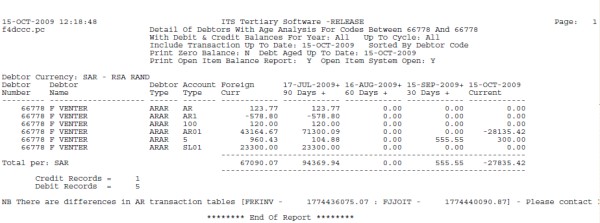 |
| User Selection | Prompt Text * an item between square brackets [ ] is the default answer |
Type & Length |
Comments |
|---|---|---|---|
| (S)ummary or (D)etail listing | A1 | ||
| Open Item Debtor Balance Report (Y)es /(N)o. | A1 | ||
| Enter your Selection Criteria: 1. By Debtor Codes 2. By Debtor Types 3. By Account Types |
N1 |
||
| For 1. First Debtor Code or ALL For 2. Enter First Debtor Type or ALL For 3. Enter First Account Type or ALL |
N9 A4 A4 |
||
| Do you Wish to see Debtors with: 1. Credit Balances 2. Debit Balances 3. Both |
N1 |
||
| Include Transactions for Year or ALL | N4 | ||
| Include Transactions up to Cycle or ALL | N2 | ||
| Do you Wish to Specify the Latest Transaction Date (Y/N) | A1 | ||
| Latest Transaction Date to be Included | DD-MON-YYYY | ||
| Age Debt as at: | DD-MON-YYYY | ||
| Do you Wish to Print and Tally Debtors with Zero Balances | A1 | ||
| Sort Order of Debtors, (A)lphabetical or (N)umeric | A1 |
| Sort Order | Per | Comments |
|---|---|---|
| As requested above. The report also shows the number of records retrieved. |
| System Select | |
|---|---|
| No special system selection. |
|
|
|
| Processing Rules |
|
|---|---|
| Debt is aged as follows: The ageing columns dates are determined by the input parameter "Age Debt as at:" and debt is aged using these dates. Non Open Item: The program selects all debit and credit transactions up to the current AR year and cycle and specified date. Credits are then applied starting with the oldest debit transactions until total credits have been applied. If total credits are greater than total debits the credit balance is displayed in the current ageing column. Open Item: The Open Item concept links receipts / credits (credit documents) to invoices (debit documents). Only documents not linked or partly applied are displayed on an open item statement indicating that the item still outstanding. If a document appeared on a statement for a period and the document is thereafter completed the documents will no longer display on the statement for the same period or if a credit document's (receipts) value is fully applied (completed) to a debit document (invoice) and both documents falls within the statement period neither the invoice or receipts will display on an Open Item Statement. Therefore it is possible that a document may never reflect on a statement as the invoice and receipt was completed before a statement was generated. The program selects all debit open items and credits not applied to a debit document up to the current AR year/cycle and specified date. Credit documents partially applied to debit documents are selected using the debit document's reference date where the debit documents reference date falls within specified period. Open Items are aged allocating the Item to the relevant ageing column. |
|
| No-Show Indicators (When documents are flagged with no-show indicators the documents are linked together through a no-show sequence) Documents flagged with No-Show Indicators are treated as follows in the report: Where a document flagged with a no-show indicator is included in the report as a result of the selection criteria, and all documents linked through the no-show sequence falls within the reporting period, all documents linked to the sequence are excluded in the calculation of the debtors balance and ageing. If a document flagged with a no-show indicator is included in the report as a and any linked documents falls outside the reports, documents flagged with no-show indicators are included in the calculation of the debtors balance and ageing. |
| Date | System Version | By Whom | Job | Description |
|---|---|---|---|---|
| 30-Oct-2007 | v01.0.0.0 | Magda van der Westhuizen | t145484 | New manual format. |
| 01-Jul-2009 | v01.0.0.1 | Charlene van der Schyff | t158351 | Edit language obtained from proof read language Juliet Gillies. |
| 30-Sep-2009 | v01.0.0.2 | Louise Stander | t156322 | Change ageing |
| 17-Sep-2010 | v01.0.0.3 | Marchand hildebrand | t169153 | Add note to manual on the how no-shows are treated in the report |